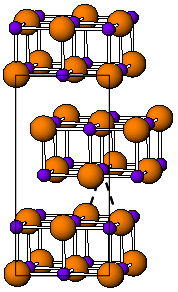Thallium(I) iodide

| |
| Names | |
|---|---|
| Other names
Thallium monoiodide
Thallous iodide | |
| Identifiers | |
3D model (JSmol)
|
|
| ChemSpider | |
| ECHA InfoCard | 100.029.272 |
PubChem CID
|
|
CompTox Dashboard (EPA)
|
|
| |
| |
| Properties | |
| TlI | |
| Molar mass | 331.29 g/mol |
| Appearance | yellow crystals red crystals above 170 °C |
| Density | 7.29 g/cm3, solid |
| Melting point | 442 °C (828 °F; 715 K) |
| Boiling point | 823 °C (1,513 °F; 1,096 K) |
| negligible | |
| Hazards | |
| Flash point | Non-flammable |
| Related compounds | |
Other anions
|
Thallium(I) fluoride Thallium(I) chloride Thallium(I) bromide |
Other cations
|
Gallium(I) iodide Indium(I) iodide |
Related compounds
|
Mercury(II) iodide Lead(II) iodide |
Except where otherwise noted, data are given for materials in their standard state (at 25 °C [77 °F], 100 kPa).
| |
Thallium(I) iodide (TlI) is a chemical compound of formula TlI. It is unusual in being one of the few water-insoluble metal iodides, along with AgI, SnI2, SnI4, PbI2 and HgI2.
Chemistry
TlI can be formed in aqueous solution by metathesis of any soluble thallium salt with iodide ion. It is also formed as a by-product in thallium-promoted iodination of phenols with thallium(I) acetate.
Attempts to oxidise TlI to thallium(III) iodide fail, since oxidation produces the thallium(I) triiodide, Tl+I3−.
Physical properties
The room temperature form of TlI is yellow and has an orthorhombic structure [1] which can be considered to be a distorted NaCl structure. The distorted structure is believed to be caused by favourable thallium-thallium interactions, the closest Tl-Tl distance is 383pm.[2] At 175 °C the yellow form transforms to a red CsCl form. This phase transition is accompanied by about two orders of magnitude jump in electrical conductivity. The CsI structure can be stabilized down to room temperature by doping TlI with other iodides such as RbI, CsI, KI, AgI, TlBr and TlCl.[3] Thus, presence of impurities might be responsible for coexistence of the cubic and orthorombic TlI phases at ambient conditions.[1] Under high pressure, 160kbar, TlI becomes a metallic conductor.
Applications
- Added to mercury arc lamps to improve their performance[4] The light produced is mainly in the blue green part of the visible light spectrum least absorbed by water, so these have been used for underwater lighting.[5]
- Used in trace amounts with NaI or CsI to produce a scintillator used in radiation scintillation detectors.
Safety
Thallium(I) iodide is, like all thallium compounds, highly toxic. Conditions/substances to avoid are: heat.
See also
General references
- WebElements
- Greenwood, Norman N.; Earnshaw, Alan (1997). Chemistry of the Elements (2nd ed.). Butterworth-Heinemann. ISBN 978-0-08-037941-8.
References
- ^ a b R. P. Lowndes and C. H. Perry "Molecular structure and anharmonicity in thallium iodide" J. Chem. Phys. 58 (1973) 271
- ^ Anja-Verena Mudring (2007). "Thallium Halides - New Aspects of the Stereochemical Activity of Electron Lone Pairs of Heavier Main-Group Elements". European Journal of Inorganic Chemistry. 2007 (6): 882–890. doi:10.1002/ejic.200600975.
- ^ S. Sultana et al. "Electrical conductivity in TlI–TiO2 composite solid electrolyte" Physica B: 404 (2009) 36
- ^ G. H. Reiling, "Characteristics of Mercury Vapor-Metallic Iodide Arc Lamps," J. Opt. Soc. Am. 54, 532 (1964)
- ^ Underwater Journal and information bulletin, IPC Science and Technology Press, (1973), p 245
